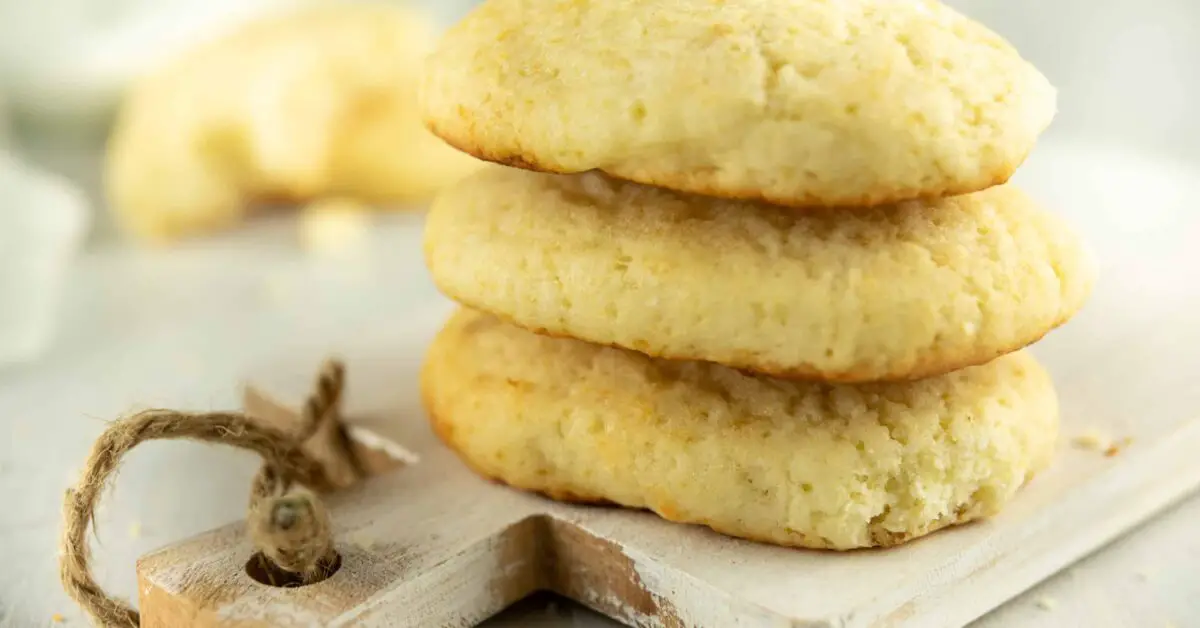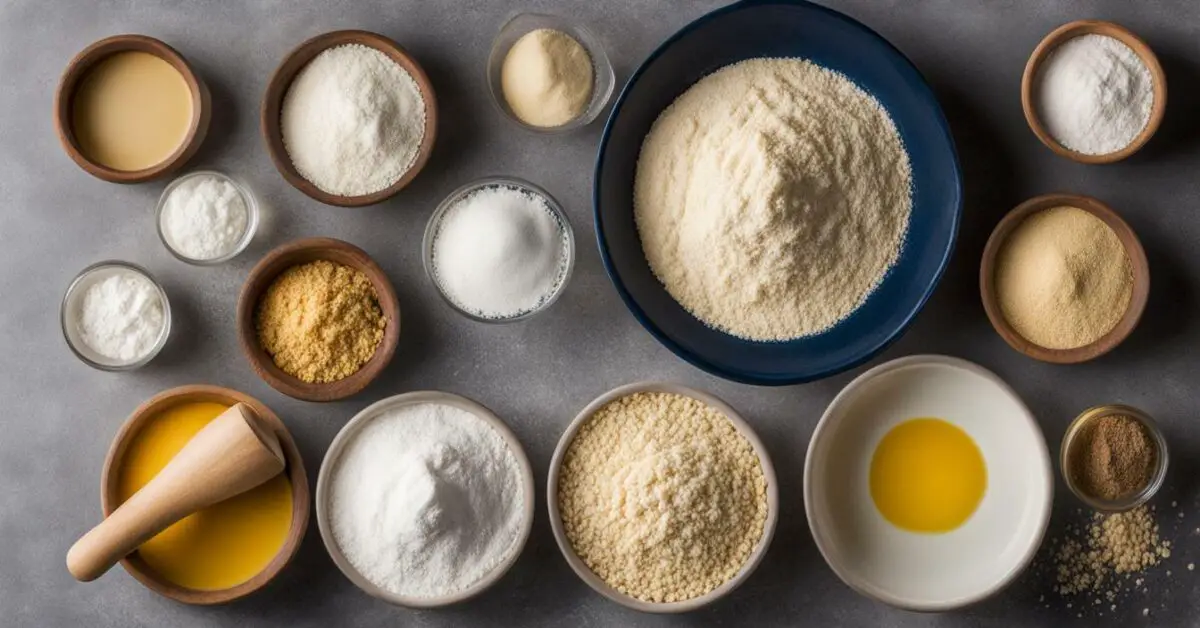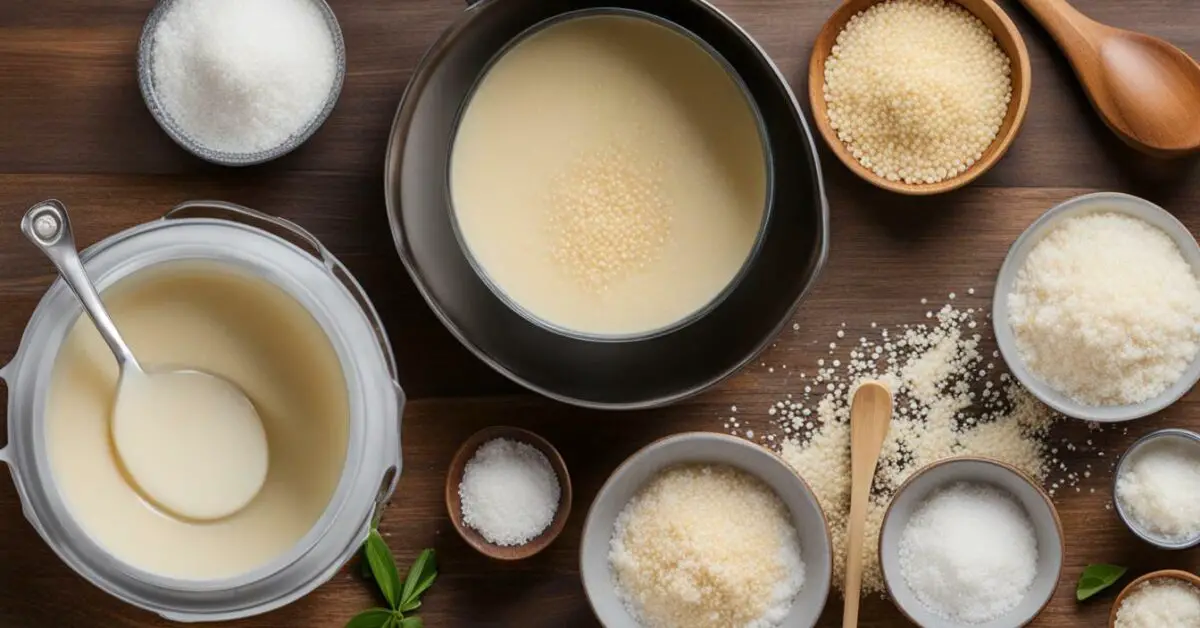
This post may contain affiliate links. Please read my disclosure for more information.
Are you looking for a substitute for cornstarch in cookies? Look no further! We’ve compiled a list of the 10 best alternatives that will ensure your cookies turn out just as delicious without cornstarch.
Key Takeaways:
- Potato starch can be used as a one-to-one substitute for cornstarch in all baking applications.
- Rice flour is a great substitute for achieving a crispy texture in cookies, but it can be more expensive.
- All-purpose flour can be used as a substitute, but it will result in a thicker texture and an opaque appearance.
- Tapioca flour is a good substitute for cornstarch in puddings and sweet sauces, but be cautious about using too much.
- Arrowroot powder works well as a thickening agent, but it’s best suited for recipes that don’t require direct heat or a long simmer.
With these alternatives, you can confidently bake your favorite cookies without worrying about the presence of cornstarch. Experiment with different substitutes and find the perfect one for your cookie recipes!
Potato Starch
One of the top substitutes for cornstarch in cookies is potato starch. Not only does it work well in all baking applications, but it can also be used in a one-to-one ratio with cornstarch. Potato starch is a versatile ingredient that provides a similar thickening effect and helps create a soft and chewy texture in cookies.
To use potato starch as a substitute for cornstarch, simply replace it in equal amounts. For example, if a recipe calls for 1 tablespoon of cornstarch, you can use 1 tablespoon of potato starch instead. This makes it an easy swap for those who have corn allergies or prefer to avoid corn-based products.
When using potato starch in cookies, it’s important to mix it with other dry ingredients before adding it to the dough. This ensures even distribution and prevents lumps from forming. Additionally, potato starch can help improve the shelf life of your cookies, making them stay fresh and tender for longer.
Benefits of Using Potato Starch as a Substitute:
- Works well in all baking applications
- Can be used in a one-to-one ratio with cornstarch
- Creates a soft and chewy texture in cookies
- Suitable for those with corn allergies or preferences
- Improves the shelf life of cookies
| Potato Starch | Cornstarch |
|---|---|
| Works well in all baking applications | Works well in all baking applications |
| Can be used in a one-to-one ratio | Can be used in a one-to-one ratio |
| Creates a soft and chewy texture | Creates a soft and chewy texture |
| Suitable for those with corn allergies or preferences | Suitable for those with corn allergies or preferences |
| Improves the shelf life of cookies | – |
Rice Flour: A Crispy Alternative to Cornstarch in Cookies
If you’re looking to achieve a crispy texture in your cookies, rice flour can be an excellent substitute for cornstarch. Not only does it provide a delicate crunch, but it also adds a unique flavor profile to your baked goods. Unlike cornstarch, rice flour is gluten-free, making it a great option for those with dietary restrictions or sensitivities.
When substituting cornstarch with rice flour, it is important to note that rice flour has a different absorption rate. This means that you may need to adjust the amount of flour in your recipe to achieve the desired consistency. Generally, you can replace cornstarch with an equal amount of rice flour, but it’s always a good idea to test a small batch before making larger quantities.
Tips for Using Rice Flour in Cookie Recipes
- Use a fine-textured rice flour for best results. This will ensure a smoother texture in your cookies.
- Consider combining rice flour with other gluten-free flours like almond flour or tapioca flour to enhance the texture and flavor.
- Be cautious with the amount of liquid in your recipe. Rice flour tends to absorb more moisture, so it’s important to adjust accordingly to prevent dry cookies.
- Allow your cookie dough to rest before baking. This will give the rice flour enough time to absorb the moisture and create a more cohesive dough.
Overall, rice flour can be a wonderful substitute for cornstarch in cookies, especially if you’re aiming for a crispy texture. Its gluten-free nature and unique flavor make it a versatile ingredient that can take your baking to new heights. So, don’t hesitate to experiment with rice flour in your favorite cookie recipes and enjoy the delightful crunch it brings!
| Substitute | Texture | Availability |
|---|---|---|
| Rice Flour | Crispy | Widely available in grocery stores |
| All-Purpose Flour | Thick and opaque | Commonly found in most kitchens |
| Potato Starch | Similar to cornstarch | Readily available in specialty stores |
| Tapioca Flour | Gummy if used in excess | Can be found in most grocery stores |
| Arrowroot Powder | Thickens well but avoid heat | Available in health food stores |
| Xanthan Gum | Thickens in small amounts | Less commonly found in pantries |
| Instant Pudding Mix | Creates a creamy texture | Typically found in grocery stores |
All-Purpose Flour
For those who prefer a thicker texture in their cookies, all-purpose flour can be a suitable substitute for cornstarch. It is a common pantry staple and readily available in most kitchens. When using all-purpose flour as a substitute, keep in mind that it will result in a denser texture and an opaque appearance.
To substitute cornstarch with all-purpose flour, use a one-to-one ratio. For example, if a recipe calls for 1 tablespoon of cornstarch, you can use 1 tablespoon of all-purpose flour instead. However, it’s important to note that the substitution may slightly alter the taste and texture of the cookies.
When using all-purpose flour as a substitute, it’s recommended to incorporate it into the recipe by combining it with the dry ingredients. This ensures that it is evenly distributed throughout the dough. Additionally, you may need to adjust the recipe slightly to achieve the desired texture. Adding an extra tablespoon of flour or reducing the amount of liquid ingredients can help achieve a thicker consistency.
Here’s a quick summary of using all-purpose flour as a substitute for cornstarch in cookies:
- Use a one-to-one ratio when substituting all-purpose flour for cornstarch.
- Incorporate the all-purpose flour into the dry ingredients.
- Adjust the recipe as needed to achieve the desired texture.
To summarize, all-purpose flour can be a suitable substitute for cornstarch in cookies, especially for those who prefer a thicker texture. By following these guidelines, you can easily adapt your cookie recipes to accommodate this substitution.
| Substitute | Texture | Appearance |
|---|---|---|
| All-Purpose Flour | Denser | Opaque |
Tapioca Flour: A Sweet Substitute for Cornstarch in Cookies
If you’re looking to add a touch of sweetness to your cookies while substituting cornstarch, tapioca flour can be an excellent choice for puddings and sweet sauces. Tapioca flour is derived from the cassava root and has a slightly sweet flavor that can enhance the taste of your desserts. In addition to its natural sweetness, tapioca flour also provides a smooth and glossy texture to your cookie recipes, making them an irresistible treat.
When using tapioca flour as a substitute for cornstarch in cookies, it’s important to note that a little goes a long way. Tapioca flour has a high starch content, which means that using too much can lead to a gummy texture. It’s recommended to use tapioca flour in moderation and gradually increase the amount as needed to achieve the desired consistency.
To incorporate tapioca flour into your cookie recipes, simply replace the amount of cornstarch called for in the recipe with an equal amount of tapioca flour. For example, if the recipe calls for 1 tablespoon of cornstarch, use 1 tablespoon of tapioca flour instead. Remember to mix the tapioca flour with other dry ingredients before adding them to the wet ingredients to ensure even distribution.
Table: Tapioca Flour as a Substitute for Cornstarch in Cookies
| Ingredient | Amount |
|---|---|
| Cornstarch | 1 tablespoon |
| Tapioca Flour | 1 tablespoon |
By using tapioca flour as a substitute for cornstarch in cookies, you can enjoy a hint of sweetness and a delightful texture in your baked treats. Experiment with different cookie recipes and variations to find the perfect balance and create unique flavors that will impress your family and friends.
Arrowroot Powder as a Substitute for Cornstarch in Cookies
When it comes to using a thickening agent as a substitute for cornstarch in cookies, arrowroot powder can be a viable option. This natural and gluten-free powder is derived from the roots of the arrowroot plant, making it a popular choice for those with dietary restrictions or preferences.
One of the benefits of arrowroot powder is its ability to thicken and provide a smooth texture to baked goods. It can be used in a one-to-one ratio with cornstarch, making it easy to substitute in recipes. However, it’s important to note that arrowroot powder is best suited for recipes that don’t require direct heat or a long simmer.
When using arrowroot powder as a substitute for cornstarch in cookies, it’s recommended to mix it with a small amount of cold liquid before adding it to your batter. This helps to prevent clumping and ensures even distribution throughout the dough. Additionally, arrowroot powder has a neutral flavor, so it won’t alter the taste of your cookies.
| Advantages of Arrowroot Powder as a Substitute for Cornstarch | Considerations for Using Arrowroot Powder |
|---|---|
| Gluten-free and suitable for those with dietary restrictions | Not suitable for recipes that require direct heat or a long simmer |
| Provides a smooth texture and thickens baked goods | May not be readily available in all grocery stores |
| Can be used in a one-to-one ratio with cornstarch | May result in a slightly softer texture compared to cornstarch |
Experimenting with different substitutes can help you find the perfect option for your cookie recipes. Whether you prefer arrowroot powder, potato starch, rice flour, or any other alternative, each substitute offers its own unique benefits and limitations. So don’t be afraid to get creative in the kitchen and explore the wide range of options available to you.
Xanthan Gum and Instant Pudding Mix: Unique Substitutes for Cornstarch in Cookies
If you’re looking for some unique substitutes for cornstarch in cookies, both xanthan gum and instant pudding mix can offer interesting alternatives. Xanthan gum is a versatile thickening agent that can be used in small amounts to replace cornstarch and create a similar texture in your cookies. It is known for its ability to improve dough elasticity and help bind the ingredients together, resulting in a chewy and moist cookie.
Instant pudding mix, on the other hand, can be an unexpected substitute for cornstarch in sweet recipes. It can add both flavor and texture to your cookies, making them extra moist and delightful. Be sure to choose a flavor that complements your recipe, such as vanilla or chocolate, to enhance the overall taste.
Using Xanthan Gum and Instant Pudding Mix
When using xanthan gum as a substitute for cornstarch, it’s important to remember that a little goes a long way. Start with a small amount, such as 1/2 teaspoon, and gradually increase if needed. Too much xanthan gum can result in a gummy texture, so use it sparingly until you achieve the desired consistency.
For instant pudding mix, follow the instructions on the packaging to determine the amount needed for your recipe. In most cases, 1/4 to 1/2 cup of instant pudding mix can be used to replace 1/4 cup of cornstarch. Keep in mind that instant pudding mix already contains sugar and flavorings, so adjust the sugar and other ingredients accordingly.
| Substitute | Advantages | Drawbacks |
|---|---|---|
| Xanthan Gum | Improves dough elasticity, creates a chewy texture | Can become gummy if too much is used |
| Instant Pudding Mix | Adds flavor and moisture to cookies | Already contains sugar and flavorings, may require adjustment of other ingredients |
Remember, these substitutes are not a one-to-one replacement for cornstarch, so it’s important to experiment and adjust your recipe accordingly. Start with small amounts and gradually increase until you achieve the desired texture and taste. Whether you choose to use xanthan gum or instant pudding mix, these unique substitutes can add a twist to your cookies and surprise your taste buds.
Conclusion
With these 10 substitutes for cornstarch in cookies, you can now confidently bake delicious treats without compromising on taste or texture. Whether you choose potato starch, rice flour, all-purpose flour, tapioca flour, arrowroot powder, xanthan gum, or instant pudding mix, each substitute has its own unique benefits and limitations. Experiment with different substitutes to find the perfect one for your cookie recipes.
Potato starch is a versatile option that can be used in a one-to-one ratio with cornstarch, making it an easy substitute to incorporate. Rice flour is great for achieving a crispy texture in cookies, but keep in mind that it may be more expensive than other alternatives. All-purpose flour can be used as a substitute as well, but be prepared for a thicker texture and an opaque appearance in your baked goods.
If you’re making puddings or sweet sauces, tapioca flour can be a good choice, but be cautious of using too much as it can result in a gummy texture. Arrowroot powder, on the other hand, works as a thickening agent but is best suited for recipes that don’t require direct heat or a long simmer. Xanthan gum and instant pudding mix are also options to consider, with xanthan gum serving as a small amount thickening agent and instant pudding mix as a substitute for cornstarch in sweet recipes.
Now that you’re armed with these alternatives, you can confidently experiment with different substitutes and create cookies that suit your preferences and dietary needs. Happy baking!
FAQ
What are some substitutes for cornstarch in cookies?
Some substitutes for cornstarch in cookies include potato starch, rice flour, all-purpose flour, tapioca flour, arrowroot powder, xanthan gum, and instant pudding mix.
How do I use potato starch as a substitute for cornstarch in cookies?
Potato starch can be used in a one-to-one ratio with cornstarch. Simply replace the cornstarch called for in the recipe with an equal amount of potato starch.
Can I use rice flour as a substitute for cornstarch in cookies?
Yes, rice flour can be used as a substitute for cornstarch in cookies that require a crispy texture. However, it may be more expensive than other alternatives.
Can I use all-purpose flour as a substitute for cornstarch in cookies?
Yes, all-purpose flour can be used as a substitute for cornstarch in cookies. However, it will result in a thicker texture and an opaque appearance.
How do I use tapioca flour as a substitute for cornstarch in cookies?
Tapioca flour is a good substitute for cornstarch in puddings and sweet sauces. Be careful not to use too much, as it can become gummy.
Can I use arrowroot powder as a substitute for cornstarch in cookies?
Yes, arrowroot powder can be used as a thickening agent in cookies. However, it’s best used in recipes that don’t require direct heat or a long simmer.
Can I use xanthan gum as a substitute for cornstarch in cookies?
Yes, xanthan gum can be used as a thickening agent in small amounts. However, it may not be readily available in your pantry.
Can I use instant pudding mix as a substitute for cornstarch in cookies?
Yes, instant pudding mix can be used as a substitute for cornstarch in sweet recipes. It adds flavor and enhances the texture of the cookies.


